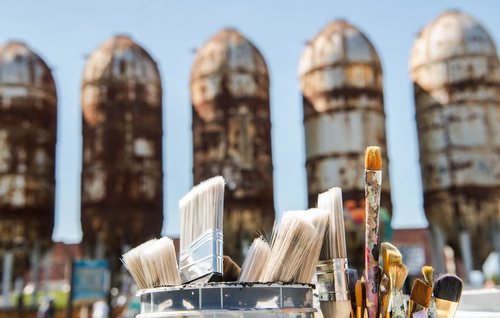FRIDAY, APRIL 5, 2024
Officials in Bellingham, Washington, have recently unveiled plans to have flaking paint removed from six digester tanks, locally known as the “rocket ships,” as a part of a makeover project.
According to the Port of Bellingham, workers will remove the old and failing paint from the almost 90-year-old vessels, allowing them to rust so that they resemble the neighboring “Acid Ball” liquid and gas tank.
The project began on April 1 and is scheduled to be completed by the end of the month by Purcell Painting and Coatings.
“Most of the paint’s already flaked off. For now, we’re just going to take the paint off and allow it to keep that cool industrial look,” Port of Bellingham spokesman Mike Hogan told the Bellingham Herald. “They’re industrial icons and part of the vibe down there.”

 |
| The Port of Bellingham |
|
Officials in Bellingham, Washington, have recently unveiled plans to have flaking paint removed from six digester tanks, locally known as the “rocket ships,” as a part of a makeover project. |
The Port of Bellingham stated that the new project will include:
Work has reportedly been coordinated with regulatory agencies including Washington State Labor and Industries, the Northwest Clean Air Agency and the Washington State Department of Ecology
Additionally, the port plans to install new history signs to explain the purpose of the tanks that were once part of the Georgia-Pacific pulp mill that took up the entire waterfront site two decades ago.
The 65-foot digester tanks were built in 1937 and worked to turn wood into pulp for products like toilet paper and paper towels on the 137-acre factory, which closed in 2001 due to rising energy costs and the Enron corporate scandal.
The report explains that logs were ground into chips and then loaded that into the digester tanks to be cooked in acid, creating the pulp. Previously, the tanks had been stored inside a building until the G-P plant closed.
The digester tanks were reportedly saved from demolition by public support to maintain them, the Acid Ball and several other buildings as examples of waterfront history.
The project comes along with the port’s efforts to redevelop the city's waterfront district. A master plan has been approved for the 237 acres on Bellingham's central waterfront to create a vibrant, mixed-use neighborhood with new parks, trails and jobs.
The area is set to be redeveloped in phases over the next 40 to 50 years of investment and development.
Previous Efforts
In 2015, demolition crews revealed the tanks that had long stood on the city’s former industrial waterfront behind brick walls.
“They’re almost like secret sculpture pieces that were hidden down there, invisible to the community,” John Reid, the architect working with Irish-developer Harcourt Developments on the first steps to renew the site at the time, told the Herald.
Earlier that year, the Port of Bellingham had announced it would hold onto the three oldest tanks for potential use during the redevelopment, but Reid and Harcourt didn’t think that would be enough. “Harcourt Developments and myself are keen to retain those,” Reid said.
After speaking with Port Executive Director Rob Fix, the six tanks were left standing rather than being scrapped for their steel.
It was suggested that the bubbling and cracking silver lead paint on the outside of the tanks be removed, the outsides primed and repainted, and the brick liners inside removed to reduce the weight of each tank.
The work also reportedly wanted the foundation to be protected from damage during demolition, and the openings on the top and bottom of each tank to be sealed.
“But the potential for this historical continuity I suppose is interesting as opposed to completely wiping out and removing everything from the site,” Reid said. “To go and create that as a modern piece of sculpture would cost a fortune. It’s just a wonderful opportunity.”
Reid said that he thought the tanks could be used throughout parks and avenues on the waterfront to pay homage to the site’s history.
“These kind of sculptural rockets have great potential to celebrate this former industrial past,” he said. “I think there’s opportunity for color, for water, for illumination.”
In line with Reid's vision for illumination, it was announced in 2021 that the tanks would be receiving lights that glow in a variety of colors depending on events and seasons.
As an example, the tanks reportedly turned sea deep blue when the Seattle Kraken hockey team got its first win, turned orange during Halloween and changed to red and green for Christmas.
The report stated that the Acid Ball would also be regularly lit up in the district as another piece of Bellingham’s manufacturing history.
Tagged categories: Coating failure; Coating Materials; Coating Materials; Coatings; Flaking; Infrastructure; Infrastructure; Metal coatings; Metals; Ongoing projects; Port Infrastructure; Program/Project Management; Rehabilitation/Repair; Restoration; Rust; Tanks